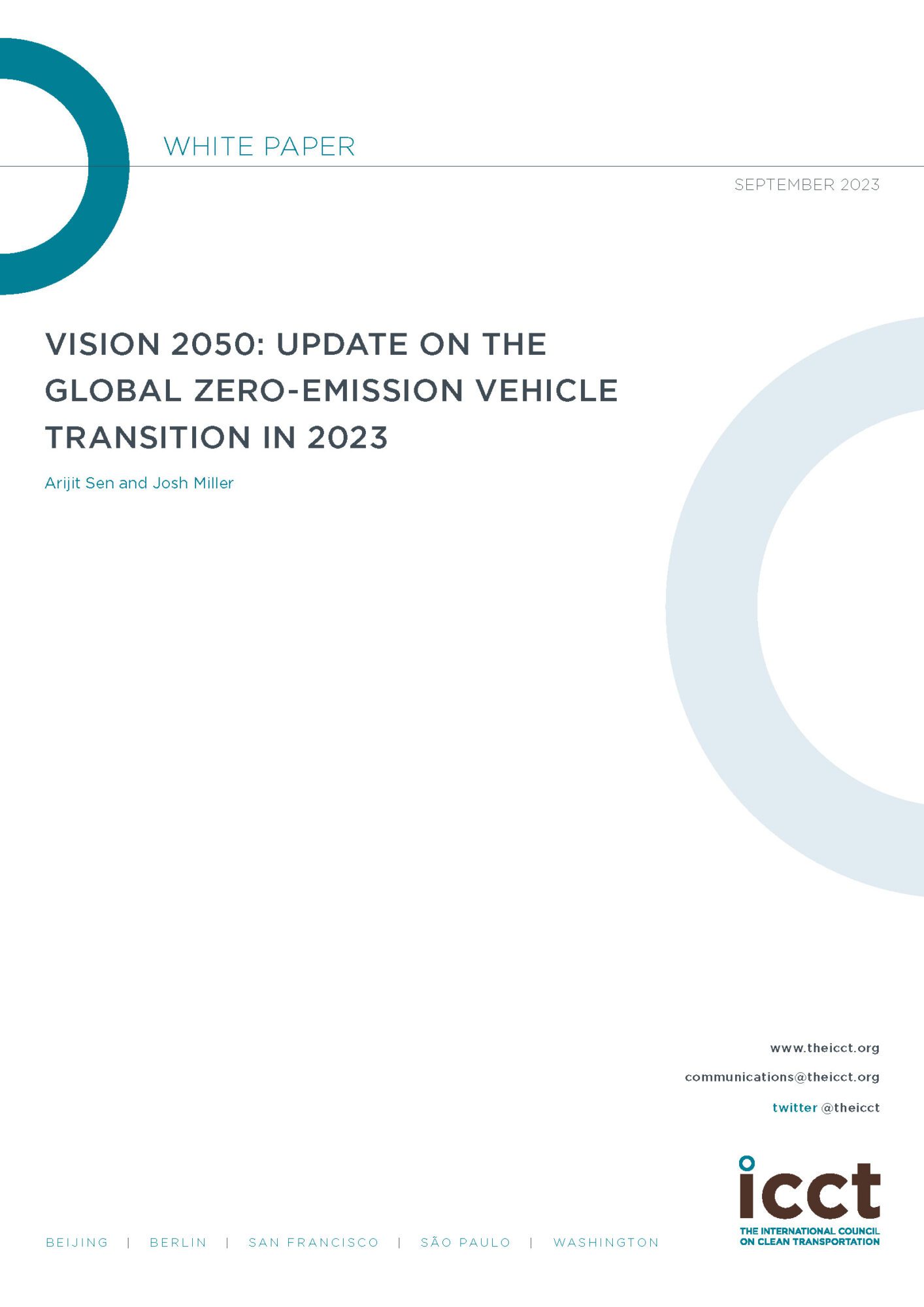Vision 2050: Update on the global zero-emission vehicle transition in 2023
Blog
Improving economics strengthen the case for ambitious EV policies to achieve Paris commitments
With the 28th United Nations Climate Change Conference underway during the warmest year in recorded history, let’s unpack three recent reports about emissions from global road transport. Despite the policy progress and encouraging market developments in recent years, when taken as a whole, these reports illuminate why further policy action on zero-emission road transport is vital for aligning with Paris Agreement climate goals.
The ICCT’s update on the transition to zero-emission vehicles (ZEVs, which include battery electric and hydrogen fuel-cell electric vehicles) found that policy momentum has noticeably accelerated in the past 2 years. If governments fulfill their domestic and international commitments, ZEVs will account for around 40% of new cars and vans sold globally in 2030, 30% of new bus sales, and 20% of new truck sales. Combined with recently adopted policies, this Political Momentum scenario is projected to avoid 42 billion tonnes of CO2 emissions through 2050 compared with the policies that had been adopted by August 2021. Those savings are big—equivalent to taking all vehicles off the world’s roads for more than 5 years—but not big enough to align with Paris Agreement goals.
Electric cars were cited as a standout of the global energy system in the latest reboot of the International Energy Agency’s Net Zero Roadmap. That report said electric cars are “in line with the milestones” that IEA defined in its normative scenario to limit warming to 1.5°C by the end of the century. By the IEA’s reckoning, announcements across the electric vehicle (EV) battery supply chain are ramping up at a pace that will allow electric car sales to make up two-thirds of new car sales by 2030 and 100% of new sales by 2035. This is good news for policymakers who might wonder whether the supply of electric cars could keep up with ambitious ZEV policies.
The latest installment of RMI’s X-change series—X-change: Cars, the end of the ICE age—presented an even more optimistic outlook of continuing EV adoption and projected that EVs will “make up between 62% and 86% of global car sales by 2030.” To support this, RMI emphasized the rapid improvements in EV batteries, including cost reductions of 88% and energy density increases averaging 6% per year from 2010 through 2022 (those trends were also cited by IEA and us at the ICCT). Yet the RMI report also noted, “we expect governments to adopt more stringent measures to reduce [internal combustion engine] ICE sales” and the “required policy actions to speed up change include a mix of regulation and infrastructure build-outs, carrots and sticks, and are analyzed in more detail by both IEA and BNEF.” This suggests a lot of policy effort underpins the 2030 projections.
So, when we consider these three studies together, what stands out?
First, to align with Paris Agreement commitments, zero-emission cars should account for at least two-thirds of new car sales globally by 2030 and reach close to 100% of new sales by 2035. Examples of policies that align with this goal include Europe’s latest CO2 standards for cars and vans, the United Kingdom’s ZEV mandate for cars and vans, and California’s Advanced Clean Cars II regulation that is being adopted by a growing number of additional U.S. states.
Second, policies have played a pivotal role in getting electric car uptake to where it is today, and further action is needed to align the sector with the Paris climate goals. The “secret sauce” is not a secret at all: it involves a combination of ZEV targets, regulations, infrastructure investments, and carrots and sticks tailored by region to ramp up supply and demand. Once these foundational policies are in place, policy attention can shift to upgrading electricity grids as needed, requiring battery supply chains to meet high environmental and due diligence standards, and ensuring that EV batteries are recycled at the end of their life.
Third, the economics of electric cars are becoming increasingly attractive, and investments in the production of batteries and electric cars and deployment of publicly accessible charging will continue to improve that value proposition. In most cases, switching to an electric car already saves consumers thousands of dollars in fueling and maintenance costs over the life of the vehicle. And the day when the sticker price of electric cars matches those of comparable conventional cars is approaching. Indeed, in some segments and markets, it has already arrived, especially when purchase incentives are factored in.
Finally, these favorable economics should give policymakers the confidence to set increasingly ambitious policies and reinforce this virtuous cycle. Our recent report on the ZEV transition found that despite the acceleration seen in the last 2 years, there is still a substantial gap between current policy ambitions and a trajectory for ZEV market growth that’s aligned with limiting warming to 2°C or below. We found that if governments achieve only their current ZEV goals and commitments, global CO2 emissions from road vehicles would be reduced by only about one-third of what’s needed to put road transport on a pathway compatible with 2°C or below. We call the remaining two-thirds of that needed mitigation the “ambition gap.”
About half of the ambition gap can be eliminated if more governments align their ZEV ambitions and adopt policies consistent with phasing out sales of new conventional cars and vans in major markets by 2035 and globally by 2040, as targeted by the growing number of signatories to the ZEV Declaration. The main challenge for cars and vans is in ensuring that the transition is truly global. The other half of the ambition gap must be closed by accelerating the ZEV transition for trucks and buses. Although market uptake and regulations for zero-emission trucks especially are currently behind those of cars and vans, the business case is already strong in many use cases, opening the possibility that zero-emission trucks could follow a similar pathway to the accelerated market growth that we’ve seen in the past 3 years for electric cars and vans. Forward-looking policies and planning are needed to make this happen, and they can help ensure the availability of zero-emission truck models, facilitate the build-out of charging networks, and direct investments in the grid to ensure reliability.
Electrifying road transport is the keystone of a broad portfolio of policies that’s needed to align road vehicles with well-below 2°C and to pursue efforts to limit warming to 1.5°C, as targeted in the Paris Agreement. Technology progress and policy success have already kickstarted a virtuous cycle, with rapid declines in EV costs and announced increases in EV supply capacity providing solid justification for more ambitious policies, which then trigger more investments and commitments across the EV ecosystem. Further acceleration of this cycle would help keep Paris targets within reach.
Authors

Jacob Teter
Independent Consultant
Related Publications
VISION 2050: UPDATE ON THE GLOBAL ZERO-EMISSION VEHICLE TRANSITION IN 2023
Updates modeling of the carbon dioxide emissions impact of an accelerated global transition to zero-emission vehicles, including by accounting for policy developments in Zero Emission Vehicles Transition Council markets to March 2023.


